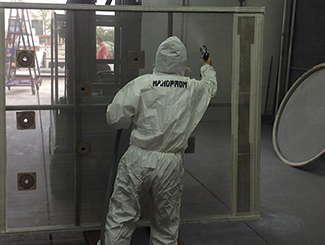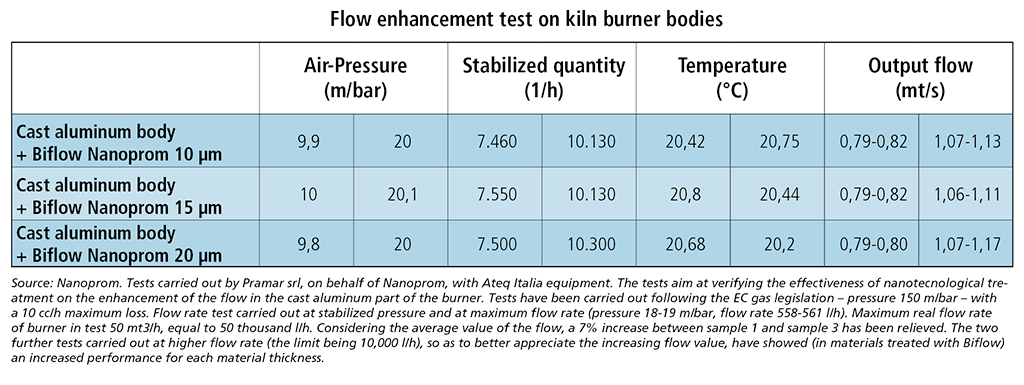 by Thomas Foschini22
Dicembre
2014
by Thomas Foschini22
Dicembre
2014
‘Nano’ to increase life and reduce costs
What do a single seat racing car wheel rim and a kiln burner for ceramics have in common? They both aim at guaranteeing excellent heat transfer: between the brake disc, the rim and the wheel in the single-seater; between flame and kiln refractories, thanks to the smoothness of air flows, in the burner.
With Polysil on the market, this is now possible. Polysil is a few micron thick silicium based coating with a very high surface resistance (6H) conferring to metal sub-layers the following properties: resistance to abrasion and oxidation, enhanced thermal conductivity, and, last but not least, greater smoothness for an increased performance (speed along the curve for racing cars; a higher flame and/or less gas consumption for kilns).
Polysil is produced and exclusively commercialized by Nanoprom, a firm set up in Sassuolo in 1997 by Gianluca Falleti. The firm has been a Polysil coating provider for the main Formula One constructors, for the Italian and Spanish sailing federation, for Tetrapak packaging multinational company, for Indesit and others. Last September Tecnargilla hosted an exclusive preview of the latest innovation for energy saving: the burner. Developed with Ancora Group, it is of great interest for the ceramic industry in terms of energy saving, kiln efficiency, longer life of the burning-body itself.
“Tests carried out over the last 6 months, says Gianluca Falleti, have pointed out to a greater stabilization of the flow upwards (that is a flame higher than 10 cm with unvaried pressure levels). Values show greater smoothness in the output flow, with the typical flickering of the flame (indicating a non-perfect combustion of the air/gas mixture) brought to zero”. The nanomaterial applied on Ancora burners has been named Biflow and is a reformulation of the already tested Polysil “so as to guarantee resistance to temperatures higher than 900°”.
“The application of Biflow – goes on Falleti – drastically reduces surface roughness on the iron parts, considerably increasing smoothness of air/gas flows and minimizing the formation and deposit of any carbon residues”. The final result is an optimum air/gas mixture and a longer flame which allows a deeper penetration in the kiln. Ceramic operators have two options available: they can count on a higher flame, and on a better performing kiln (leaving consumption unvaried); or optimize consumption, reducing gas pressure (leaving performance unvaried).
Increased kiln efficiency is just one of the positive features of the product: “Tests carried out have underlined high resistance to wear, to abrasion, to oxidation”, a low surface tension as well as self cleaning properties”. That is to say that the life of nozzle and diffuser has been stretched out, meaning further saving on kiln maintenance.
As part of Sol-Gel based coatings family currently raising an increasing interest in the ceramic industry, Polysil (together with its variants such as Biflow) is actually a sort of “liquid glass” applied in 5 to 20 μm thicknesses. These sub-layers “are much thinner than traditional coatings”, Falleti underlines. If the application of the burner has been designed with Ancora on an exclusive partnership and currently provides all Vulcan product range (but trade agreements with other producers are not being ruled out by the Nanoprom), it is actually the use of the product in dry grinding nets that may be of interest for the ceramic industry,
“As to nets, Falleti explains, the first product was developed with the traditional Polysil formula and dates back to 2012, with exclusive supply to Manfredini & Schianchi”, Sassuolo-based manufacturer for grinding plants and machinery and for the screening of raw materials. Here are the final results: “The nets treated with Polysil – here the product is applied with an electrostatic gun – show an increased filtering capacity of about 30%”, points out Falleti, thanks to self-cleaning properties and therefore minor residue on the net. Among other benefits, an increase in the life of nets of about 2 to 6 months, due to a less frequent need to clean them from residues. In this case too, the layer of product is much thinner than usual (8 μm compared to traditional coating 20-30 μm) and much lighter too, making the repainting of the surface to give it a second life a valid option. And this is one of the reasons why Polysil has been particularly appreciated by the sailing industry – these very weeks Giovanni Soldini is sailing around the world on his Maserati, the racing yacht with a Polysil-“painted” hull, while Andrea Mura is racing the Route Du Rhum. Applications for aeroplanes turbines are also being studied.
But it is once again the ceramic industry the target for the next Nanoprom innovation, the pigmented Polysil for cold glazing: the new product, which has already been tested on mosaics, enables considerable savings on warehouse management (since the white piece of ceramics can be cold glazed, and orders sorted out in real time). It also enables glazed surface resistance to chemicals and corrosion. The innovation may be applicable also for highly decorated wall tiles where gold or other precious metals are employed.
